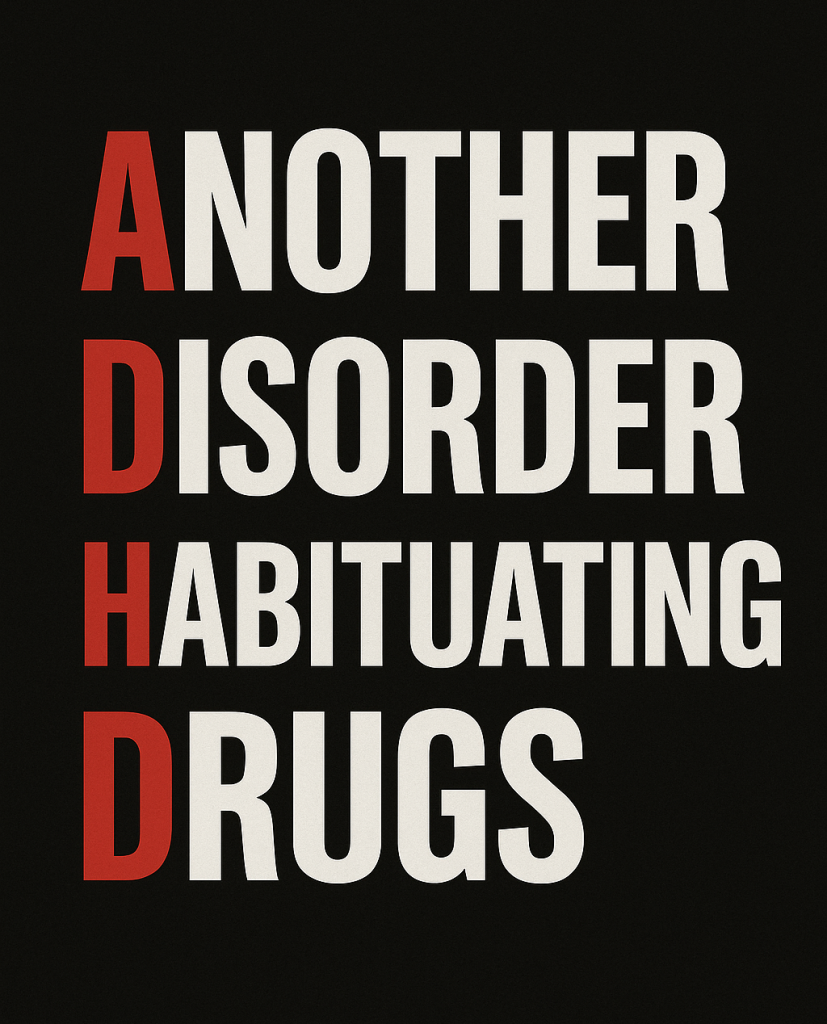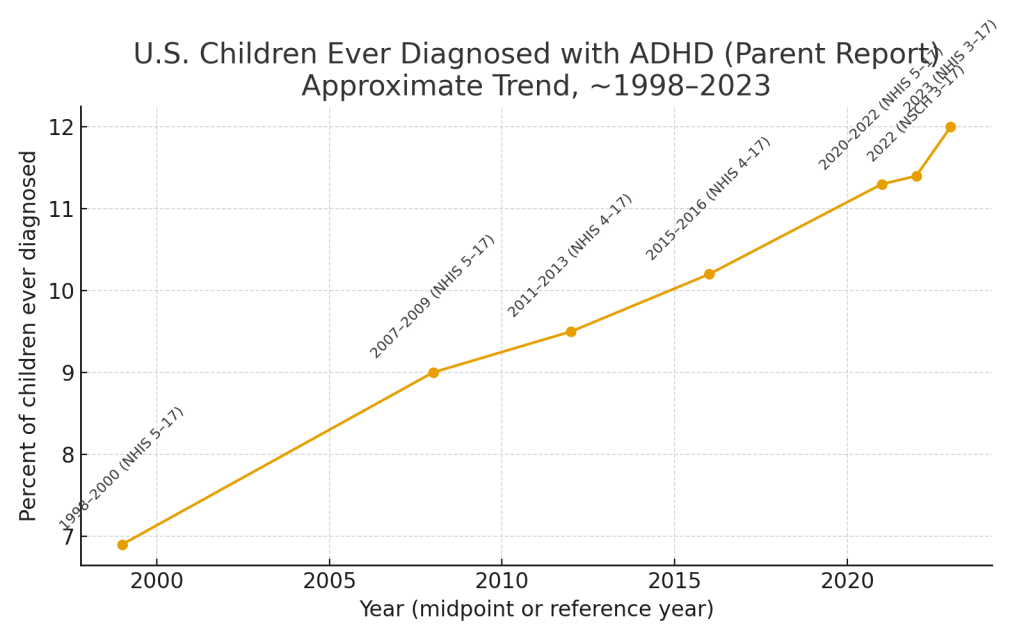When Normal Behavior Becomes Diagnosis
- NYC’s Gateway Drug to Communism
- Fairness Killed Freedom
- The Forgotten Half
- Manhood is Broken and the Fix is 500 Years Old
- The Forgotten Half

I recently read an article on how ADHD is underdiagnosed. I won’t share the article or author, for obvious reasons. I’m not interested in putting this guy in the line of fire. He’s doing genuine work, with the goal of helping. And as Michael from Passion Pit recently stated, we can disagree with respect, especially if someone is genuinely trying to help those suffering. To be clear, I am not a psychiatrist nor a psychologist. I am a mental health counselor. This is the perspective from which I write.
The author said he would address:
- How science proves underdiagnoses
- Why ADHD is more prevalent now
- Concerns about medication for treatment of ADHD
What I Can Agree On
Some of what he laid out made sense and is likely to be true. For instance, he stated ADHD is 74% heritable. I have no reason to doubt that. This places the heritability of ADHD almost as high as height (80%) and much higher than depression (35%-40%). He gave stats on stimulants, both the lack of findings that they are terrible for you and what happens when some don’t take them. For the most part, I can understand and buy this. This still lines up with a recent article I read that states it is possible for ADHD to be real and true, but to also be overdiagnosed.
The Author’s Diagnosis of Underdiagnosis
He continued with “science” that “proves” ADHD is underdiagnosed. I was left wanting. For instance, he relied on Adderall to determine diagnose prevalence. He said that 41 million Adderall prescriptions were written in 2023, severly lower than those diagnosed. He stated that 8.8% of adults had ADHD. Then linked a CDC report that showed that 8.8% of girls between the ages of 3-17 had ADHD. The latest data we have on adults diagnosed with ADHD is 6%, or 15.5M adults. There are approximately 31 million girls between the ages of 3-17 in America. 8.8% of that is 2.7 million. Let’s take the 15% of boys diagnosed (which I highly question this validity), which is 5.4. million boys. Combine that with the 2.7 million girls, and the 15.5 million adults. That’s 23.6 million people diagnosed.
Therefore, 41 million Adderall prescriptions is severely higher than diagnosis. But let’s assume he means that the 41 million is total but that one person gets 12 prescriptions per year (as he alludes to in his piece), which is also doubtful because they write refills into the prescriptions, not new prescriptions. Then it’s 3.4 million people of the 23.6 million diagnosed with ADHD who are taking Adderall.
Ok, that’s lower. But this doesn’t account for other medications used and behavioral treatment. And to suggest that behavioral treatment isn’t enough is patently false, I can tell you from personal experience. So we’re left wondering, is it one prescription, 4, 6, or 12 prescriptions? Most are 90-day refills. By that math, it would mean that almost half of those diagnosed with ADHD are taking Adderall. So that’s “severly low?” They all must be taking adderall to be considered normal?
But this is where it all takes a severe turn for me. He never addressed:
- Suppression of science
- Increase in prevalence
- Means of calculating underdiagnosis other than Adderall
Supression of Science
It is pretty widely known that the freedom of science is under attack. More and more reports come out each year of studies that get suppressed when they fail to meet a predictable, Marxist ideology (Soh, 2020). If the study, in any way, misaligns with identity ideology, regardless of the fact that these are objective findings, the study is suppressed, and the authors are cancelled and sometimes fired. Just ask James Nuzzo. As an unfortunate result, it is becoming increasingly difficult to trust science is presenting all angles of an issue.
Increase of Prevalence
Next, this article, nor any article I’ve ever read has accounted for the sharp and distinct increase in diagnoses in the last 25 years, and especially in the last 10 years. The only explanation is “we missed it all this time.” Which does not hold up. So in 1998, 6.9% of children were diagnosed with ADHD, and in 2023, over 12% of children were diagnosed with ADHD. It doubled because we just “missed it” all this time? Or did it double because in 1994, the DSM-IV broadened the diagnosis for ADHD, which coincidentally sent a few pharma reps to Cabo on a private plane. I know, anecdotal and not causation. I get it. But the coincidence is remarkable. And much more plausible than “we just missed it.”

Underdiagnosed or Overmedicated?
Here’s another part missing from the “underdiagnosed” club. Even if they’re right, medication isn’t always the answer, and is a problematic solution on its best day. My bonus son came to me the other night and out of the blue said, “You know, I feel like I still have ADHD, but I know how to handle it, keep the symptoms at bay, and control my impulses now after all of the things you’ve taught me. I feel… normal” You know what this says? That it isn’t merely neurological, and maybe not even mostly neurological. It is behavioral. Which means the solution is often behavioral. So what did I teach him? I’ll give you two examples.
Example 1:
When I came into his life, he was 8. When he had something to say, he’d start yelling it in the next room as he was approaching the room he knew his mother was in. I consistently stopped him in his tracks, made him go back into the other room and reenter the room, quietly looking to see if anyone was already talking, refrain from interrupting if they are, and restate what he wanted to say. It took nearly 2 years for this to take hold of him. But he eventually got it. We created a new standard, consistently required him to meet this standard, and over time, he did. They’re Capable!
Example 2:
My bonus daughter has a 4 year old son who simply “can’t sit still.” So he and I, along with another daughter are at a restaurant. He gets on top of something and I tell him to get down. He looked at me like, “who are you?” I tell him again. He still doesn’t get down. I go pick him up, carry him to my seat, and sit him next to me. I tell him he’s not getting up again. He states his disapproval. I set a consequence if he continues. He stops… for 20 MINUTES STRAIGHT! We sat calmly and had a typical conversation. This means, he was capable, but he was never held to this standard. The food comes out, he’s fine and starts telling me how much he loves cheese. I said, “Don’t we all, my man!” They’re Capable!
Conclusion
I am open-minded. I am willing to learn. And I want to be challenged. But if the best you have is that the usage of Adderall is the “scientific proof” of underdiagnosis, forgive me if I’m not convinced. In my experience, both as a father and my clinical experience, behavioral adaptations to most symptoms indicative of societal ADHD still work better than medication. I know because I’ve witnessed it and treated it, personally. I’d now like to get back to talking about things like how pineapple should never be put on pizza.
Stay Classy GP!
Grainger
References
Soh, D. (2020). The end of gender: debunking the myths about sex and identity in our society (First Threshold Editions hardcover edition. ed.).

